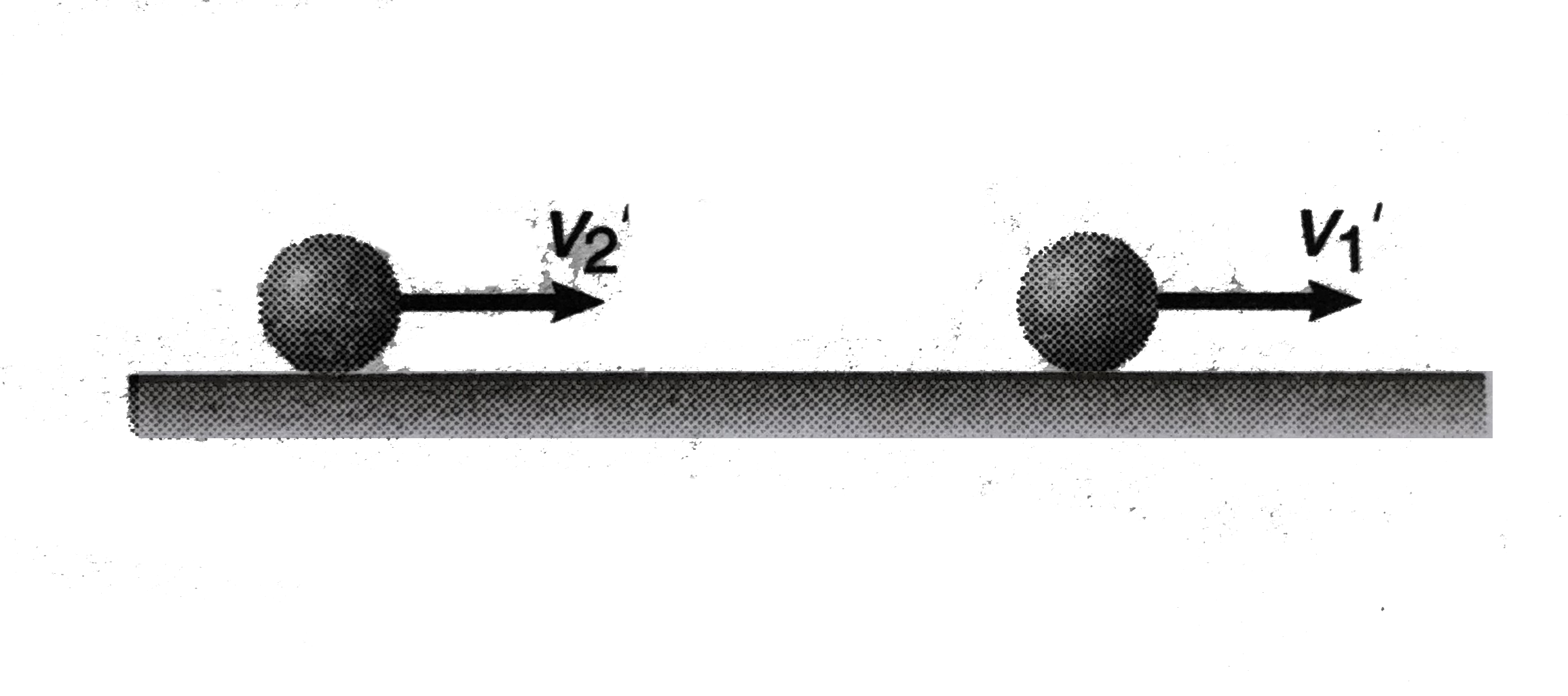A ball of mass mm, moving with a speed 2υ0, collides inelasticaly (e>0) with an identical ball at rest. Show that (a) For head - on collision, both the balls move forward.
(b) For a genergcollision, the angle between the two velocities of scattered balls is less that 90∘.
For head on collision . Let v1 and v2 be velocities of the two balls after collision
From law of conservation of linear momentum
m×2v0=mv1+mv2
or 2v0=v1+v2 ….(i)
Now
e=relative velocity of separation after collision relative velocity of approach before collision
or e=v2−v12v0
v2−v1=2ve0 ...(ii)
[ From equation (i) v2=2v0−v1]
2v0−2v1=2v0e
or 2v1=2v0(1−e)
or v1=v0(1−e)
As e<1 , so v1 has the same sign as v0 , so the ball moves forward after collision .
(b) For general collision
→p=→p1+→p2
Since in inealstic collision , some KE is lost , so
p22m>p212m+p222m
[∴E=mv22=m2v22m=p22m]
or p2>p21+p22, it will be possible when θ is acute or less then 90∘ .

Thus →p,→p1and→p1 are related on shown in figure .Here θ is acute (θ<90∘) ( if p2=p21+p22 then it would five θ=90∘).
Topper's Solved these Questions
- BOOK - MODERN PUBLICATIONCHAPTER - WORK, ENERGY AND POWER EXERCISE - Higher Order Thinking Skills & Advanced Level15videos
WORK, ENERGY AND POWER
- BOOK - MODERN PUBLICATIONCHAPTER - WORK, ENERGY AND POWER EXERCISE - Revision Exercise (Very Short Answer Questions)31videos
WORK, ENERGY AND POWER
- BOOK - MODERN PUBLICATIONCHAPTER - WORK, ENERGY AND POWER EXERCISE - NCERT FILE (NCERT Exemplar Problems (Very Short Answer Type Questions))12videos
WORK, ENERGY AND POWER
- BOOK - MODERN PUBLICATIONCHAPTER - WAVESEXERCISE - CHAPTER PRACTICE TEST14videos
WAVES
Similar Questions
A ball of mass m moving with velocity v collides head on elastically with another identical ball moving with velocity - V. After collision
View SolutionA ball of mass m moving with a speed u1 collides elasticity with another identical ball moving with velocity u2.
(a) Find the velocities of the balls after collision if the impact is direct.
(b) Find the angle between velocities after collision if they collide obliquely and u2=0View Solution
Knowledge Check
- Question 1 - Select One
A billiard ball moving with a speed of 5m/s collides with an identical ball, originally at rest. If the first ball stop dead after collision, then the second ball will move forward with a speed of:
A10ms−1B5ms−1C2.5ms−1D1.0ms−1 - Question 2 - Select One
A billiard ball moving with a speed of 5m/s collides with an identical ball, originally at rest. If the first ball stop dead after collision, then the second ball will move forward with a speed of:
A10m/sB5m/sC2.5m/sD1m/s - Question 3 - Select One
A ball of mass m moving with a speed v makes a head on collision with an identical ball at rest. The kinetic energy after collision of the balls is three fourth of the original kinetic energy. The coefficient of restitution is
A12B13C1√2D1√3
A ball of mass m moving at a speed v makes a head on inelastic collision with an identical ball at rest. The kinetic energy of the balls after the collision is 34th of the original. Find the coefficient of restitution.

 View Solution
View SolutionA ball of mass m moving with a speed 2v0 collides head-on with an identical ball at rest. If e is the coefficient of restitution, then what will be the ratio of velocity of two balls after collision?
View SolutionA ball of mass M moving with speed v collides perfectly inelastically with another ball of mass m at rest. The magnitude of impulse imparted to the first ball is
View SolutionA ball of mass m is moving with velocity u and collides head on with another identical body at rest . What is the maximum possible loss of kinetic energy due to collision ?
View SolutionA ball of mass m moving with a velocity v undergoes an oblique elastic collision with another ball of the same mass m but at rest. After the collision if the two balls move with the same speeds , the angle between their directions of motion will be:
View Solution

